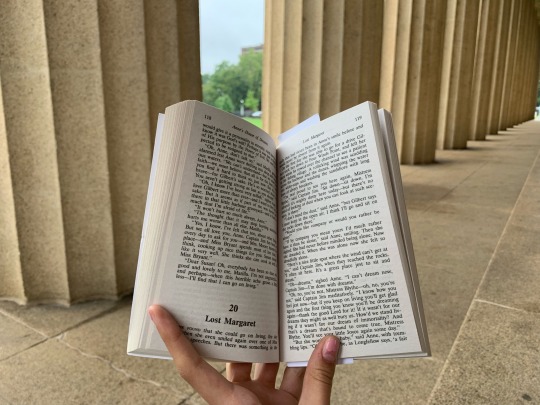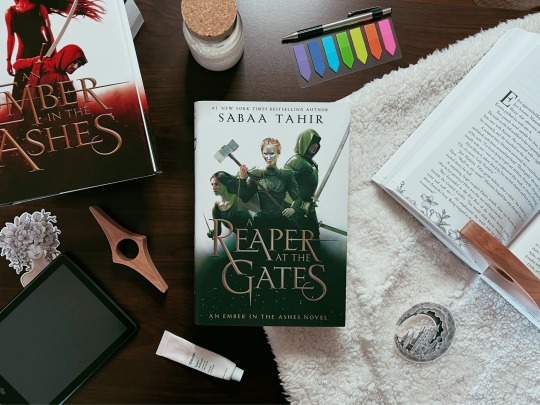English teacher, writer, book and coffee lover, and etc.
Don't wanna be here? Send us removal request.
Photo






Painting by David Mensing (b.1963, Iowa)
Instagram
Follow CrossConnectMag for more
13K notes
·
View notes
Text
Ok, real quick, speaking as a librarian, you absolutely cannot despair about the adult literacy crisis and shame adults for reading fiction books you do not personally care for or think are "challenging" at the same time. It doesn't work with kids, and it doesn't work with adults.
Here's how to increase someone's reading level:
1) Let them read whatever they choose without shame or judgment. Maybe get them talking about it using open-ended, non-leading questions to encourage critical thinking and comprehension.
2) Let them get bored after a while and seek out different books.
3) Repeat.
30K notes
·
View notes
Text
It has seemed quite clear to me for some time that the commercial Broadway theater industry is broken and entirely replacing it with nonprofit theater may be the only way to fix it, and it seems ever more apparent today.
480 notes
·
View notes
Text
“Give your mind a job to do, or else it will find a job to do, and you might not like the job it invents.”
Elizabeth Gilbert, Big Magic: Creative Living Beyond Fear
593 notes
·
View notes
Text
🎉 Write characters that you find interesting and compelling.
🎉 Don't worry about making characters too over the top, or 'too much'.
🎉 Write characters who want big things.
🎉 Write characters with conflict between what they want and what they need.
🎉 Write characters who don't realize they are doing harm.
🎉 Write characters who don't know how to communicate well.
🎉 Write characters with people they love in the way of what they want.
🎉 Write characters with amazing abilities who use them in ways that unintentionally fuck them over.
🎉 Write messy characters!
5K notes
·
View notes
Text

Spent the day setting out the rest of my seed starts. Rearranging house plants, planted in the garden. I think I earned myself some hammock time with a mutual recommended book.
My soul is currently at peace.
50 notes
·
View notes
Text
The Writer's Guide to Mastering Dialogue
You've heard it a thousand times—show, don't tell. One of the most effective ways to do this in your writing is through dialogue. Dialogue helps bring your story and characters to life, propels the action forward, and engages readers. But crafting realistic, compelling dialogue is an art form that takes practice. Don't worry, Rin's got you covered. In this guide, you'll discover techniques for writing dialogue that sparkles. You'll learn how to make conversations sound natural, differentiate character voices, convey subtext and emotion, and use dialog for exposition. By the end, you'll be writing dialogue with confidence and watching your characters come to life on the page. So grab a cup of coffee or mocha (my favorite), settle in, and let's chat about the art of conversation.
Why Dialogue Matters in Your Novel
Dialogue is one of the most powerful tools in a writer's arsenal. It brings your story to life and creates realistic characters that readers can connect with. If you want to master the art of fiction writing, you need to know how to write compelling dialogue.
Dialogue reveals character and moves the story forward. Through dialogue, readers get a sense of your characters' personalities, backgrounds, and motivations. It's a chance to show, not tell, what your characters are like. Dialogue also propels the action and builds suspense, as characters chat about the events unfolding in the story.
There are a few keys to crafting believable and engaging dialog:
•Make it sound natural. Listen to real conversations for inspiration. Dialogue should flow and feel spontaneous, not stiff or forced. Use contractions, interruptions, and imperfect speech.
•Give each character a unique voice. The way people speak depends a lot on their background, education level, profession, and personality. Capture the subtleties of different speaking styles to bring your characters to life.
•Use dialogue tags and actions. Adding "he said/she said" and descriptions of characters' actions and expressions during conversations helps readers keep track of who's talking and provides context. Use a variety of tags like asked, exclaimed, and murmured.
•Move the conversation along. Keep dialog concise and avoid unnecessary filler words. Get to the point so readers stay interested in what's being said. Dialogue should always move the story forward.
•Show tension and conflict. Interesting conversations often involve disagreement, sarcasm, arguing, or questioning. Create tension through dialogue to keep readers engaged.
With the right techniques, you can make dialogue a pivotal part of your story. So listen, observe, and practice the art of great conversation - your readers will thank you!
Developing Distinctive Character Voices Through Dialogue
To develop distinctive voices for your characters, focus on how they speak. Dialogue is one of the best ways to bring your characters to life and propel your story forward.
Pay attention to your characters’ backgrounds, experiences, education levels, and attitudes. All of these factors influence how people talk in real life, so apply that to your characters. Maybe your wise-cracking character uses a lot of humor and sarcasm, while your shy character speaks hesitantly in short sentences.
Listen for speech patterns, accents, and catchphrases in real conversations and note them for inspiration. Capture the rhythm and flow of natural dialogue.
Give each character their own vocabulary based on their interests, jobs, and lifestyles. The tech geek’s dialogue will differ from the history professor’s.
Establish characters’ voices from their first lines of dialog. Look for a memorable way for them to express themselves. The impatient character may frequently use phrases like “spit it out already!” while the pessimist’s go-to is “what could possibly go wrong?”
Use dialog to reveal aspects of characters’ personalities and backgrounds without telling readers directly. Show, don’t tell. For example, a character who says “please” and “thank you” in every sentence likely has a polite and courteous nature.
Read dialogue aloud to make sure it sounds natural. Get friends or family members to read different characters’ lines. If anything sounds off, rework it.
With practice, crafting distinct voices for your characters through dialog will become second nature. Your characters' voices, conveyed through the words they say and the way they say them, will make your story come alive for readers. So take the time to get to know your characters by how they speak. Their voices are worth developing.
Using Dialogue to Reveal Character
Reveal Character Through Dialogue
Dialog is one of the best ways to reveal details about your characters and show their personalities. Carefully crafted conversations can expose a character's background, values, education level, and more without telling the reader outright.
As your characters talk, think about what kinds of words and phrases they would use based on who they are. An older British gentleman will speak very differently than a teenage skateboarder from California. Listen to people with similar backgrounds and life experiences to your characters for inspiration.
Also consider:
The rhythm and cadence of their speech. Do they speak quickly or slowly? Formally or casually?
Their vocabulary. Does your character use complex words and jargon or simpler language?
Grammar and pronunciation. Does your character follow the rules or have their own way of speaking?
For example, here's a short exchange that shows the contrast between two characters:
Jenny (teenage skateboarder): "Hey, you gonna drop in on the half pipe today or just pose by the ramp again?"
Mr. Edwards (older British gentleman): "I'm afraid vert skating is a young man's game, my dear. I'm quite content to watch you whippersnappers from the sidelines."
Even from this brief conversation, you get a sense of each character's age, background, and attitude without the author explicitly telling you. Mastering the art of subtext in dialog will make your stories come alive and allow readers to discover the depth in your characters for themselves.
Driving the Plot Forward With Meaningful Dialogue
To keep your readers engaged, your dialog needs to propel the story forward. Meaningful exchanges between characters should reveal information, create conflict, and raise the stakes.
Share Relevant Details
Use dialogue as an opportunity to share important details about the characters, their relationships, backstories, and the world they inhabit. For example:
“Did you hear they’re raising tuition again next semester?” Jenny asked.
“Ugh, not again,” Mark groaned. “How are we supposed to afford another five percent?”
This exchange informs the reader that Jenny and Mark are college students struggling with the costs. Look for natural ways to slip in context through dialog without sounding forced.
Create Conflict
Interesting stories thrive on tension, disagreement, and clashing perspectives. Have your characters bicker, argue, and challenge each other. For example:
“You never listen to me!” Alice shouted. “You always have to be right.”
“I’m not trying to be right,” Brian retorted. “I’m trying to protect you, but you’re too stubborn to see that.”
The quarrel fuels the underlying conflict in their relationship and keeps readers wondering how they’ll resolve their differences.
Raise the Stakes
Use meaningful dialog at key moments to increase the urgency, suspense or importance of what’s happening in the story. For example:
“The test results came back—it’s not good news,” the doctor said grimly.
Not only does this distressing announcement raise the stakes for the character’s health issue but it also creates a cliffhanger, leaving the reader wondering about the diagnosis and anxiously awaiting more details.
Meaningful dialog is essential for crafting an engaging story. Use it to inform readers, create conflict between characters, raise the stakes, and propel the plot toward a climax. With practice, writing authentic dialog will become second nature.
Creating Tension and Conflict Through Dialogue
To keep readers engaged, effective dialog should create tension and conflict between characters. As in real life, the conversations in your story should have stakes and push characters outside their comfort zone.
Show underlying tensions
Have characters disagree and argue to reveal underlying tensions. For example:
“You never listen to me. It’s always about what you want.”
“That’s not fair and you know it. I’ve sacrificed a lot for this family.”
This type of emotionally-charged exchange shows the couple has deeper issues to work through regarding resentment and lack of appreciation.
Create awkward situations
Put characters in awkward situations through dialog to ramp up the tension. For example:
“How’s the job search going?”
“Um, still looking. The market’s tough right now.”
“Really? I heard your company is hiring. I put in a good word for you with some people I know there.”
“Oh. Thanks, I guess.”
The second character is now in the difficult position of admitting the job search isn’t going well and they don’t actually have any leads. This cringeworthy moment translates the tension to readers.
Issue challenges and ultimatums
Have characters challenge each other by issuing warnings, demands or ultimatums, for example:
“If you walk out that door, we’re through. I mean it this time.”
“Don’t threaten me. You need me more than I need you.”
Throwing down the gauntlet in this way forces characters to back up their words with actions, which heightens the tension and conflict. Readers will keep reading to see who comes out on top!
Using dialog that highlights tension, creates awkwardness, and issues challenges is a great way to craft page-turning scenes that keep readers on the edge of their seats. Mastering the art of writing gripping dialogue is key to writing a story that resonates.
Avoiding Common Dialogue Mistakes
One of the biggest mistakes new writers make is crafting unrealistic or clichéd dialog. Your characters’ conversations should flow naturally and sound believable to readers. Avoid these common dialog doners:
Repeating Characters' Names
In real life, we rarely use someone's name in every sentence when talking to them. Only use a character's name when beginning a new exchange or for emphasis. Repeating names too often makes the dialog sound unnatural.
Overusing Exposition
Don't have characters explain things solely for the reader's benefit. Only include exposition that makes sense for the characters to actually say to each other. Find other creative ways to convey important backstory or worldbuilding details.
Forgetting Emotion
Dialog without emotional cues like facial expressions and body language can seem flat. Use emotive verbs and adverbs to show how the lines are delivered. For example, "she exclaimed" or "he muttered angrily." Also describe characters' physical reactions and behaviors to further bring the scene to life for readers.
Talking in Complete Sentences
Real conversations are often choppy, filled with interruptions, tangents, and imperfect grammar. Vary your sentence structure and length. Use fragments, run-ons, and breaks when appropriate. Not all dialog needs to be in perfectly punctuated full sentences.
Clichéd Phrases
Certain overused phrases like "it's quiet...too quiet" or "we've got company!" indicate lazy or clichéd writing. Come up with original ways for your characters to express themselves that fit with their unique personalities and situation. Avoid reusing trite or familiar sayings.
With practice, writing natural-sounding dialog will become second nature. Pay close attention to how real people speak, and aim to replicate the flow and cadence in your writing. Follow these tips, and your characters' conversations will truly come alive on the page!
Formatting Dialogue Correctly
When writing dialog, formatting it correctly is key to making it clear and compelling for readers. Here are some tips for formatting your dialogue effectively:
Use quotation marks
Place all dialogue between double quotation marks (“”). This indicates the character is speaking. For example:
“Hello,” she said. “How are you today?”
Start a new paragraph for each new speaker
Having each character's dialog on its own line makes it easy to follow who's talking. For example:
“Did you finish your homework?” Mom asked.
“I'm almost done,” I replied. “Just have some math problems left.”
Describe the speech
Use speech tags like "said", "asked", "replied" to indicate how the dialog was delivered. For example:
“I don't want to go to bed yet,” the little girl whined.
Punctuate properly
Place punctuation such as periods, commas, question marks, etc. within the quotation marks. For example:
“Where are you going?” she asked.
I said, “To the store. Do you need anything?”
Use beats
"Beats" are actions or descriptions that replace the "he/she said" tags. They make dialog more engaging and help set the scene. For example:
"I'm tired." John yawned and rubbed his eyes.
"Then go to sleep." Mary folded her arms, annoyance in her tone.
Avoid over-tagging
Don't tag every single line of dialog with "said" or the character's name. Let context and formatting do some of the work for you. For example:
"Did you talk to Mom today?"
"Yeah, she called this morning."
"What did she say?"
"That she'd be home in time for dinner."
Following these guidelines will make your dialogue clear, compelling, and help bring your story to life. Readers will appreciate dialog that flows naturally and is easy to follow.
Using Dialogue Tags Effectively
To write effective dialog, you need to master the use of dialog tags. Dialog tags are the parts of speech that indicate who is speaking, such as “he said” or “she asked”. When used properly, dialog tags can enhance your story without distracting the reader.
Choose tags that match the tone
Pick dialog tags that match the emotional tone of the dialog. For example, use “he whispered” for hushed speech or “she shouted” for loud, angry speech. Avoid reusing the same generic tags like “he said/she said” repeatedly, but don't get too creative either. Stick with simple verbs that imply the manner of speech.
Use action tags
Action tags describe a character's physical actions or expressions while speaking. For example, "“I’m not going,” he shook his head.” or ““What a day!” She ran her hands through her hair and sighed.” Action tags bring dialog to life and help the reader visualize the scene. They also give you an opportunity to reveal character details.
Drop the tag when implied
Once two characters establish a back-and-forth dialog, you can often drop the dialog tags altogether. As long as it's clear who is speaking, the tags become unnecessary. For example:
“Did you finish your homework?” Mom asked.
“Most of it,” I said.
“Most of it? What didn’t you finish?”
“Just some math problems. I’ll do them after dinner.”
“You’d better. I’m checking it tonight.”
After the first two lines, the reader understands that Mom and I are the speakers, so the remaining dialog does not need tags. Dropping implied tags creates a snappier feel and prevents repetitive, unnecessary tags.
Using a mix of well-placed dialog tags, action tags, and implied dialog, you can craft seamless conversations between characters that flow naturally, without distraction. Keep practicing and listening to real-world conversations for inspiration. With time, writing compelling dialog will become second nature.
FAQs About Writing Dialogue
When writing dialogue, questions inevitably come up. Here are some of the most frequently asked questions about crafting realistic and compelling dialogue.
Do I use quotation marks or italics?
In fiction writing, use quotation marks (“”) to denote direct speech. Only use italics for thoughts or emphasis. Quotation marks allow the reader to easily distinguish between dialog and narration.
How do I avoid “he said, she said”?
To prevent repetitive “he said/she said” tags, use action tags that describe the speaker's actions or expressions. For example:
“We should get out of here,” he whispered, glancing around nervously.
She slammed her fist on the table. “Why didn’t you tell me sooner?”
You can also drop the dialog tag altogether if the speaker is clearly identified through context or action. The dialog itself and how you structure the conversation can imply the tone.
How do I make dialogue sound natural?
Pay attention to the cadence and rhythm of actual conversations. Dialog should:
Sound like natural speech, not formal writing. Contractions are okay!
Have an easy back-and-forth flow. Keep responses concise and avoid monologs.
Capture unique speech patterns based on a character's background and personality.
Include interruptions, changes in subject, and imperfect grammar. We don't speak perfectly in real life!
What are the rules for punctuating dialog?
Use a comma between the dialogue tag and the dialog: “Hello,” she said.
If the dialog tag comes before the dialog, end it with a comma: She said, “Hello.”
If the dialogue is interrupted by a dialog tag, use commas to separate it from the tag: “Hello,” she said, “how are you?”
Use a period to end a sentence of dialog: “Hello.”
Use a question mark for a question: “How are you?” she asked.
Use an exclamation point for excitement or emphasis: “Wow!” he exclaimed.
Start a new paragraph each time the speaker changes.
Following these tips will have you crafting dialog like a pro in no time. Let me know if you have any other questions!
Additional Tips For Writing Dialogue
Keep it concise
When writing dialog, less is more. Keep exchanges brief and avoid long speeches. Readers will get bored quickly if characters drone on and on. Focus on using just enough dialog to convey key information or advance the scene.
Use natural language
Write dialog like people really speak. Use casual language, contractions, slang, and imperfect grammar. Drop words like “um”, “like”, and “you know” into conversations to make them sound authentic. Read your dialog aloud to ensure it flows naturally. If it sounds stilted or awkward when spoken, it will come across that way to readers as well.
Share emotions
Dialog should reveal characters’ emotions and attitudes. Have characters express feelings like excitement, frustration, fear or affection through their word choice, tone, and body language. For example, a character who sighs, rolls their eyes or speaks in a sarcastic tone conveys a very different emotion than one who smiles, makes eye contact and speaks enthusiastically.
Keep it relevant
All dialog should serve a purpose, whether to reveal something about a character, advance the plot or set a mood. Avoid “empty” exchanges that fill space but add no value. If a conversation seems pointless or dull, cut or rewrite it.
Use action and description
Don't rely solely on dialog to carry a scene. Include action and descriptions to give readers a more complete picture. For example:
"Where were you?" Anna asked.
Mark sighed and ran his fingers through his hair. "I got stuck at work. I'm really sorry."
The description of Mark's actions and appearance helps the reader understand his emotional state and see the full context of the conversation.
Leave room for interpretation
Don't have characters over-explain or outright state their feelings and motivations. Leave some details to the reader's imagination. For example, instead of:
"I'm angry that you lied to me," Amy said angrily.
Try:
Amy folded her arms and glared at him. "You lied to me."
The emotional context is clear without having to explicitly state Amy's anger. Subtlety and nuance in dialog make for a more engaging read.
Conclusion
So there you have it, the keys to mastering dialogue/dialog in your writing. I ope my extensive research was enough information for you all. Focus on listening to the voices around you, develop unique voices for your characters, keep your exchanges tight and impactful. Remember, dialog should always move the story forward, not just fill space on the page. With practice, writing compelling dialog can become second nature. Now go eavesdrop on conversations, study your favorite books and shows, and get to work crafting those conversations. Your characters and readers will thank you for it. Keep at it and before you know it, you'll be writing dialog with the best of them!
(Keep in mind I used both dialog and dialogue just in case there's a few who get annoyed with that.)
Join my discord server if you'd like to talk to other writers, authors, and anyone who love writing like you. receive updates on exclusive content! Don't miss out.
Want me to turn Your character into a Artbreeder portrait? Fill this form out!
Copyright © 2023 by Ren T.
TheWriteAdviceForWriters 2023
781 notes
·
View notes
Text
Let me tell you about my new favourite cookbook

Hey tumblr. Are you trying to learn to cook for yourself? I sure am. My roommate just got me this book and I am totally blown away — it’s an entire cooking course in one book easy and accessible, taking you from following recipes to making up your own by teaching you the science behind it all. Do you love science? I love science. I especially love DIAGRAMS!

You can’t quite see it, but this tells you not just what parts to eat, but how to prepare it. I’m always in grocery stores staring at veg going “okay but what do I DO with it?” and this book actually answers that in clear, simple language and beautiful watercolours.

What’s the difference when recipes call for different types of frying? Hey, I guess I know now!

Illustrations instead of photos encourage you to play around instead of trying to get the exact same result.
Samin Nosrat, the author, is incredibly personable along with being a great writer and chef. The prose parts of the book are clearly worded and full of personality. It explains details of cooking that lots of other cookbooks leave out, meaning a intermediate cook like me can actually grasp skills like breaking down a whole chicken or getting the heart out of fresh artichokes.
The first half of the book is meant to be read straight through and explains the theory behind the elements of food in a casual writing style. Then it has 100 recipes that are meant to teach you all the basic skills and are a jumping-off point, because what she really wants you to do is EXPERIMENT! I can’t wait to eat a bunch of this stuff.
I don’t know about you, but I failed to learn cooking from my mom even though she’s a great cook. I regret it now and want to learn to be comfortable in the kitchen, because I love eating and I want to take back control of the food I eat. When I got this book, the first random page I flipped to had a matrix explaining what works well with avocado. I knew right away it was going to be my kind of book. (I ended up staying up late reading it.)
So if you’re also trying to learn to cook, to take back control of what you eat, want a really pretty illustrated cookbook, whatever — I can’t recommend this enough.
11K notes
·
View notes
Text
This is why classes need library instruction
Student: I can’t find any scholarly articles on this subject!
Me: Okay, what’s the subject?
Student: Creating a culture of sharing in west-coast technological companies.
Me: Alright, and what/where have you tried searching?
Student: I searched “creating a culture of sharing in west-coast technological companies” on the library website!
Me:

47K notes
·
View notes
Text
Love, love, love this staging of Much Ado About Nothing!
If you haven’t seen it yet, do yourself a kindness and seek it out. You will NOT regret it!
This delivery kills me every time
15K notes
·
View notes
Text

“Do you know, Gilbert, there are times when I strongly suspect that I love you!”- L.M. Montgomery, Anne of Windy Poplars
(more anne of green gables content, it’s never ending)
61 notes
·
View notes
Text

7 Days 7Covers
Day 3: Neil Gaiman, Neverwhere
Rules: Every day (read as: when I remember) I will post the cover of a book that I love and nominate someone new to start the challenge.
Tagging in @godzilla-reads (if you want to do this)
41 notes
·
View notes
Text
Destroy the myth that libraries are no longer relevant. If you use your library, please reblog.
189K notes
·
View notes
Text
stop. judging. people. based. on. what. they. like. to. read.
if you like to read romance books read romance books.
if you like to read classics read classics.
if you like to read children's books read children's books.
read whatever the fuck makes you happy.
2K notes
·
View notes
Text

“Curse this world for what it does to the mothers, for what it does to the daughters. Curse it for making us strong through loss and pain, our hearts torn from our chests again and again. Curse it for forcing us to endure.”
A Reaper at the Gates by Sabaa Tahir
87 notes
·
View notes
Text

I picked this up at the library today and haven’t been able to put it down.
📖 Diary of a Young Naturalist by Dara McAnulty
76 notes
·
View notes
